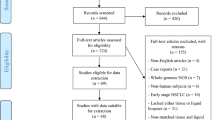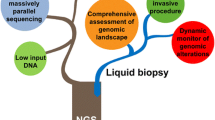Abstract
The discovery of new target treatments for NSCLC has led to a search for new genetic and epigenetic markers able to selectively predict response to these new drugs. Somatic mutations in EGFR and KRAS genes are routinely analyzed to predict response to tyrosine kinase inhibitors (TKIs), used in the treatment of NSCLC patients, whose efficacy depend on the presence or the absence of specific mutations. MicroRNA (miRNA) expression evaluation has been recently analyzed because of the involvement of these molecules in lung cancer pathogenesis and in drug resistance. Only 30 % of NSCLC patients present a resectable stage at time of diagnosis so tissue samples cannot be the only starting material for genetic and epigenetic analysis. Therefore, the possibility to use cytological sampling already used for diagnosis also for molecular testing is emerging. The aim of this study was to evaluate for the first time in lung cancer the use of liquid-based cytology both for EGFR and KRAS mutational testing and for the expression trend of some miRNAs involved in lung cancer pathogenesis: miR-21, miR-155, miR-7, and let7a. We enrolled 20 fine-needle aspirate (FNA) samples diagnosed as NSCLC, 10 FNAs without neoplastic cells, and tissue samples coming from 5 of the 20 patients who underwent surgery after FNA NSCLC diagnosis. All Thin-Prep processed FNA samples were evaluable for DNA and RNA analysis and results were compared with those of the small group of patients whose matched tumor histology was available. The mutational status of the EGFR and KRAS genes and the expression profile of the selected miRNA showed comparable results between FNA samples and histological tissues. Our results underline that cytological samples could give the same genetic information as that obtained from histological specimens and so could be collected to create a nucleic acids bank.

Similar content being viewed by others
References
Travis, W. D., Brambilla, E., Muller-Hermelink, H. K., et al. (2004). World Health Organization. Tumors of the lung, pleura thymus, and heart. Classification of tumors. Lyon: IARC Press.
Fojo, T., et al. (2007). Multiple paths to a drug resistance phenotype: Mutations, translocations, deletions and amplification of coding genes or promoter regions, epigenetic changes and microRNAs. Drug Resistance Updates, 10, 59–67.
Costanzo, R., Piccirillo, M. C., Sandomenico, C., et al. (2011). Gefitinib in non small cell lung cancer. Journal of Biomedicine and Biotechnology, 2011, 815269.
Lynch, T. J., Bell, D. W., Sordella, R., et al. (2004). Activating mutations in the epidermal growth factor receptor underlying responsiveness of non-small-cell lung cancer to gefitinib. New England Journal of Medicine, 350, 2129–2139.
Pao, W., Miller, V. A., Politi, K. A., et al. (2005). Acquired resistance of lung adenocarcinomas to gefitinib or erlotinib is associated with a second mutation in the EGFR kinase domain. PLoSMed, 2, e73.
Massarelli, E., Varella-Garcia, M., Tang, X., et al. (2007). KRAS mutation is an important predictor of resistance to therapy with epidermal growth factor receptor tyrosine kinase inhibitors in non-small-cell lung cancer. Clinical Cancer Research, 13, 2890–2896.
Hummel, R., Hussey, D. J., & Haier, J. (2010). MicroRNAs: Predictors and modifiers of chemo- and radiotherapy in different tumor type. European Journal of Cancer, 2, 298–311.
Markou, A., Liang, Y., & Lianidou, E. (2011). Prognostic, therapeutic and diagnostic potential of microRNAs in non-small cell lung cancer. Clinical Chemistry and Laboratory Medicine, 49, 1591–1603.
Saito, M., Schetter, A. J., Mollerup, S., et al. (2011). The association of microRNA expression with prognosis and progression in early stage, non small cell lung adenocarcinoma: A retrospective analysis of three cohorts. Clinical Cancer Research, 17, 1875–1882.
Yanaihara, N., Caplen, N., Bowman, E., et al. (2006). Unique microRNA molecular profiles in lung cancer diagnosis and prognosis. Cancer Cell, 9, 189–198.
Takamizawa, J., et al. (2004). Reduced expression of the let-7 microRNAs in human lung cancers in association with shortened postoperative survival. Cancer Research, 64, 3753–3756.
Chou, Y. T., Lin, H. H., Lien, Y. C., et al. (2010). EGFR promotes lung tumorigenesis by activating miR-7 through a Ras/ERK/Myc pathway that targets the Ets2 transcriptional repressor ERF. Cancer Research, 70, 8822–8831.
Pilotti, S., Rilke, F., Gribaudi, G., & Damascelli, B. (2010). Fine needle aspiration biopsy cytology of primary and metastatic pulmonary tumors. Acta Cytologica, 26, 661–666.
Nikolaidis, G., Raji, O., Markopoulou, S., et al. (2012). DNA methylation biomarkers offer improved diagnostic efficiency in lung cancer. Cancer Research, 72, 5692–5701.
Leng, S., Do, K., Yingling, M. C., et al. (2012). Defining a gene promoter methylation signature in sputum for lung cancer risk assessment. Clinical Cancer Research, 18, 3387–3395.
Kulawik, J., Gornicka, B., Krenke, R., et al. (2010). The value of cytological diagnosis of small cell lung cancer. Pneumonologia i Alergologia Polska, 78, 203–210.
Schreiber, G., & McCrory, D. C. (2003). Performance characteristics of different modalities for diagnosis of suspected lung cancer: Summary of published evidence. Chest, 123, 115S–128S.
Delgrado, P. I., Jorda, M., & Ganjeie-Azar, P. (2000). Small cell lung carcinoma versus other lung malignancies: Diagnosis by fine-needle aspiration cytology. Cancer, 90, 279–285.
Dey, P., Luthra, U. K., George, J., et al. (2000). Comparison of thinprep and conventional preparation on fine needle aspiration cytology material. Acta Cytologica, 44, 46–50.
Tisserand, P., Fouquet, C., Marck, V., et al. (2003). ThinPrep-processed fine-needle samples of breast are effective material for RNA- and DNA-based molecular diagnosis: Application to p53 mutation analysis. Cancer, 99, 223–232.
Paradiso, A., Tommasi, S., Pinto, R., Carpagnano, G. E., & Foschino-Barbaro, M. P. (2008). Exhaled breath condensate is not suitable to detect EGFR somatic mutations. European Respiratory Journal, 32, 1126–1127.
Tommasi, S., Pinto, R., Petriella, D., et al. (2011). Oncosuppressor methylation: A possible key role in colon metastatic progression. Journal of Cellular Physiology, 226, 1934–1939.
Schmittgen, T. D., & Livak, K. J. (2008). Analyzing real-time PCR data by the comparative CT method. Nature Protocols, 6, 1101–1108.
Kontzoglou, K., Moulakakis, K. G., Alexiou, D., et al. (2007). The role of liquid-based cytology in the investigation of colorectal lesions: A cytohistopathological correlation and evaluation of diagnostic accuracy. Langenbeck’s Archives of Surgery, 392, 189–195.
Schuurbiers, O. C., Looijen-Salamon, M. G., Ligtenberg, M. J., & Van der Heijden, H. F. (2010). A brief retrospective report on the feasibility of epidermal growth factor receptor and KRAS mutation analysis in transesophageal ultrasound- and endobronchial ultrasound-guided fine needle cytological aspirates. Journal of Thoracic Oncology, 5, 1664–1667.
Van Eijk, R., Licht, J., Schrumpf, M., et al. (2011). Rapid KRAS, EGFR, BRAF and PIK3CA mutation analysis of fine needle aspirates from non-small-cell lung cancer using allele-specific qPCR. PLoS ONE, 6, e17791.
Mapelle, U., De Rosa, N., Rocco, D., et al. (2012). EGFR and KRAS mutations detection on lung cancer liquid-based cytology: A pilot study. Journal of Clinical Pathology, 65, 87–91.
Nikiforova, M. N., Tseng, G. C., Steward, D., Diorio, D., & Nikiforov, Y. E. (2008). MicroRNA expression profiling of thyroid tumors: Biological significance and diagnostic utility. Journal of Clinical Endocrinology and Metabolism, 93, 1600–1608.
Szafranska, A. E., Doleshal, M., Edmunds, H. S., et al. (2008). Analysis of MicroRNAs in pancreatic fine-needle aspirates can classify benign and malignant tissues. Clinical Chemistry, 54, 1716–1724.
Ellis, M., Davis, N., Coop, A., et al. (2002). Development and validation of method for using breast core needle biopsies for gene expression microarray analyses. Clinical Cancer Research, 8, 1155–1166.
Sotiriou, C., Powles, T., Dowsett, M., et al. (2002). Gene expression profiles derived from fine needle aspiration correlate with response to systemic chemotherapy in breast cancer. Breast Cancer Research, 4, R3.
Acknowledgments
The authors would like to thank Caroline Oakley for language revision. Partially supported as a Project of the Integrated Program of the Italian Ministry of Health and of Lega Italiana per la Lotta contro I Tumori (LILT––2008).
Author information
Authors and Affiliations
Corresponding author
Rights and permissions
About this article
Cite this article
Petriella, D., Galetta, D., Rubini, V. et al. Molecular Profiling of Thin-Prep FNA Samples in Assisting Clinical Management of Non-Small-Cell Lung Cancer. Mol Biotechnol 54, 913–919 (2013). https://doi.org/10.1007/s12033-012-9640-6
Published:
Issue Date:
DOI: https://doi.org/10.1007/s12033-012-9640-6




